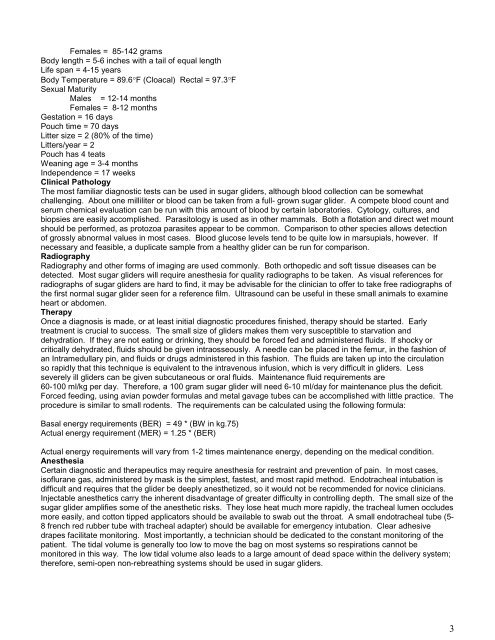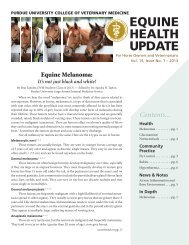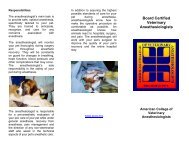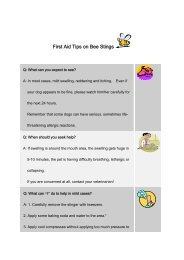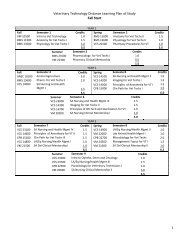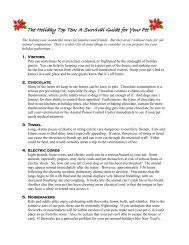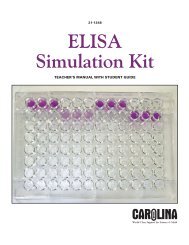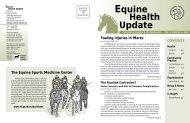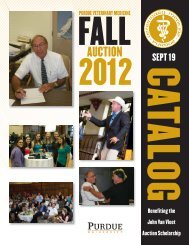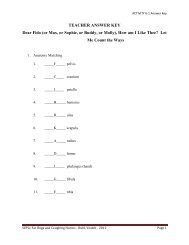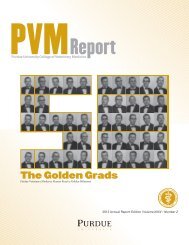Sugar Gliders - Purdue University School of Veterinary Medicine
Sugar Gliders - Purdue University School of Veterinary Medicine
Sugar Gliders - Purdue University School of Veterinary Medicine
Create successful ePaper yourself
Turn your PDF publications into a flip-book with our unique Google optimized e-Paper software.
Females = 85-142 grams<br />
Body length = 5-6 inches with a tail <strong>of</strong> equal length<br />
Life span = 4-15 years<br />
Body Temperature = 89.6°F (Cloacal) Rectal = 97.3°F<br />
Sexual Maturity<br />
Males = 12-14 months<br />
Females = 8-12 months<br />
Gestation = 16 days<br />
Pouch time = 70 days<br />
Litter size = 2 (80% <strong>of</strong> the time)<br />
Litters/year = 2<br />
Pouch has 4 teats<br />
Weaning age = 3-4 months<br />
Independence = 17 weeks<br />
Clinical Pathology<br />
The most familiar diagnostic tests can be used in sugar gliders, although blood collection can be somewhat<br />
challenging. About one milliliter or blood can be taken from a full- grown sugar glider. A compete blood count and<br />
serum chemical evaluation can be run with this amount <strong>of</strong> blood by certain laboratories. Cytology, cultures, and<br />
biopsies are easily accomplished. Parasitology is used as in other mammals. Both a flotation and direct wet mount<br />
should be performed, as protozoa parasites appear to be common. Comparison to other species allows detection<br />
<strong>of</strong> grossly abnormal values in most cases. Blood glucose levels tend to be quite low in marsupials, however. If<br />
necessary and feasible, a duplicate sample from a healthy glider can be run for comparison.<br />
Radiography<br />
Radiography and other forms <strong>of</strong> imaging are used commonly. Both orthopedic and s<strong>of</strong>t tissue diseases can be<br />
detected. Most sugar gliders will require anesthesia for quality radiographs to be taken. As visual references for<br />
radiographs <strong>of</strong> sugar gliders are hard to find, it may be advisable for the clinician to <strong>of</strong>fer to take free radiographs <strong>of</strong><br />
the first normal sugar glider seen for a reference film. Ultrasound can be useful in these small animals to examine<br />
heart or abdomen.<br />
Therapy<br />
Once a diagnosis is made, or at least initial diagnostic procedures finished, therapy should be started. Early<br />
treatment is crucial to success. The small size <strong>of</strong> gliders makes them very susceptible to starvation and<br />
dehydration. If they are not eating or drinking, they should be forced fed and administered fluids. If shocky or<br />
critically dehydrated, fluids should be given intraosseously. A needle can be placed in the femur, in the fashion <strong>of</strong><br />
an Intramedullary pin, and fluids or drugs administered in this fashion. The fluids are taken up into the circulation<br />
so rapidly that this technique is equivalent to the intravenous infusion, which is very difficult in gliders. Less<br />
severely ill gliders can be given subcutaneous or oral fluids. Maintenance fluid requirements are<br />
60-100 ml/kg per day. Therefore, a 100 gram sugar glider will need 6-10 ml/day for maintenance plus the deficit.<br />
Forced feeding, using avian powder formulas and metal gavage tubes can be accomplished with little practice. The<br />
procedure is similar to small rodents. The requirements can be calculated using the following formula:<br />
Basal energy requirements (BER) = 49 * (BW in kg.75)<br />
Actual energy requirement (MER) = 1.25 * (BER)<br />
Actual energy requirements will vary from 1-2 times maintenance energy, depending on the medical condition.<br />
Anesthesia<br />
Certain diagnostic and therapeutics may require anesthesia for restraint and prevention <strong>of</strong> pain. In most cases,<br />
is<strong>of</strong>lurane gas, administered by mask is the simplest, fastest, and most rapid method. Endotracheal intubation is<br />
difficult and requires that the glider be deeply anesthetized, so it would not be recommended for novice clinicians.<br />
Injectable anesthetics carry the inherent disadvantage <strong>of</strong> greater difficulty in controlling depth. The small size <strong>of</strong> the<br />
sugar glider amplifies some <strong>of</strong> the anesthetic risks. They lose heat much more rapidly, the tracheal lumen occludes<br />
more easily, and cotton tipped applicators should be available to swab out the throat. A small endotracheal tube (5-<br />
8 french red rubber tube with tracheal adapter) should be available for emergency intubation. Clear adhesive<br />
drapes facilitate monitoring. Most importantly, a technician should be dedicated to the constant monitoring <strong>of</strong> the<br />
patient. The tidal volume is generally too low to move the bag on most systems so respirations cannot be<br />
monitored in this way. The low tidal volume also leads to a large amount <strong>of</strong> dead space within the delivery system;<br />
therefore, semi-open non-rebreathing systems should be used in sugar gliders.<br />
3


